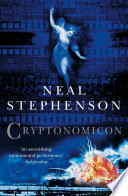Overview of Cryptonomicon by Neal Stephenson Link to heading
Summary Link to heading
Cryptonomicon is a novel by Neal Stephenson that intricately weaves together multiple narratives set in both World War II and the late 1990s. The book explores themes such as cryptography, data privacy, military history, and the evolving role of technology in society. The World War II storyline follows mathematician and cryptanalyst Lawrence Pritchard Waterhouse and U.S. Marine Bobby Shaftoe as they work on breaking Axis codes. The modern-day narrative focuses on Waterhouse’s grandson, Randy, and his venture to establish a data haven in Southeast Asia. Both timelines gradually converge, revealing hidden connections and secrets related to encrypted treasure and international espionage.
Review Link to heading
Cryptonomicon is lauded for its rich storytelling, detailed exploration of cryptography, and the seamless blending of historical and contemporary narratives. Neal Stephenson’s ability to interlace complex technical discussions with engaging fiction has been particularly praised. However, some critiques point to the novel’s sprawling length and dense technical passages, which may deter readers unfamiliar with computer science or cryptography. The book has had a significant impact, inspiring interest in coding and tech communities, and is often considered a precursor to Stephenson’s later works focused on digital themes.
Key Takeaways Link to heading
- The novel highlights the ever-growing importance of encryption and data security in the digital age.
- It presents a reflection on how historical events shape modern technical challenges and geopolitical landscapes.
- Through its elaborate plot, the book emphasizes the interconnectedness of different generations and the long-lasting effects of wartime decisions.
- It showcases Stephenson’s penchant for blending science fiction elements with real-world historical events and technical accuracy.
Recommendation Link to heading
Cryptonomicon is recommended for readers with an interest in historical fiction, cryptography, and technology. Fans of intricate, multi-layered narratives and those who enjoy exploring technical subjects within a fictional context will likely find this book rewarding. Due to its robust technical content, it might particularly appeal to enthusiasts of computer science and history buffs intrigued by the role of cryptography in warfare and modern technology.
